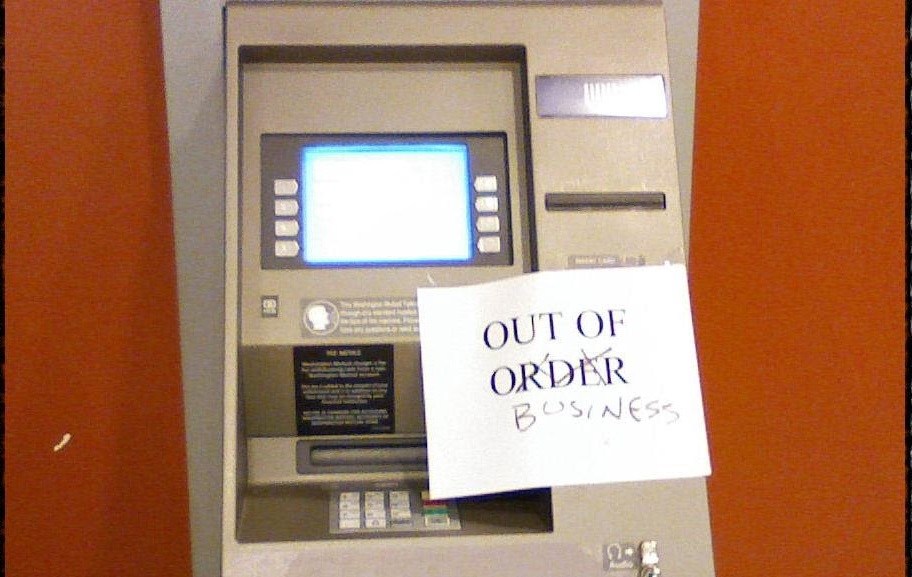
by Brian Shilhavy
Editor, Health Impact News
Pam Martens of Wall Street On Parade exposed in her column today how the FTX crypto exchange, which is now bankrupt because too many people tried to withdraw their funds at the same time exposing how it was all a big Ponzi scheme, operated the same way as the Federal Reserve does in printing money out of thin air.
What does this mean? It means that U.S. banks are just as guilty in running a fraudulent Ponzi scheme as FTX, and that we are just one bank run away where too many people try to withdraw their funds all at the same time where the entire U.S. financial system will collapse.
FTX Was Creating Money Out of Thin Air Like the Fed; and Trading Its Own “Stock” Like the Wall Street Mega Banks in their Dark Pools
If one looks very closely at the structure of FTX, the collapsed crypto exchange now in bankruptcy and causing everything it touched to teeter, it was actually using a technique of the U.S. central bank – the Fed – to create money out of thin air; and a technique we’ve been writing about repeatedly since 2014, Wall Street mega banks trading their own stocks in their own Dark Pools, effectively making a market in their own stock.
Let’s start with our comparison of what FTX was doing to the Fed’s creation of money out of thin air by pushing an electronic button. You don’t have to take our word for what the Fed is doing. The Fed actually created an educational video to explain how it creates electronic money out of thin air. That video was released in 2011 and the spokesman for the Fed says this in the video: “The Fed will not keep buying large amounts of securities on an ongoing basis,” noting that “Its purchases are a temporary measure to help the economy recover.”
At the time of that video on January 14, 2011, the Fed had used its magic money button to buy up $2.2 trillion of debt securities from Wall Street, thus pushing the interest rates on debt instruments artificially lower. And despite that promise that this would be a “temporary measure” the Fed continued over the next decade to use its magic money spigot to the point that it now holds $8.256 trillion of debt securities on its balance sheet and it can’t figure out how to unwind that monster pile of debt securities without collapsing the U.S. economy.
What Sam Bankman-Fried, co-founder and CEO of FTX, did with the help of his colleagues, was to create their own magic money creation tool. It was a crypto token called FTT and was backed by nothing more than the hyped reputation of FTX and Sam Bankman-Fried. In that sense, it traded much like the “stock” of FTX.
And much like the price of debt on Wall Street was levitated by the Fed’s $8 trillion buying binge over a decade, the price of FTT soared through a buying binge by FTX and Sam Bankman-Fried’s own hedge fund, Alameda Research. FTT’s price went from less than $4 in December 2020 to more than $84 in September 2021 – a 2,000 percent gain in less than a year. (And all those sophisticated institutional investors in FTX didn’t find that suspicious?) This morning FTT is trading at $1.61 – despite the fact that some very sophisticated investors in FTX have written down their investment to zero. (Full article.)
Meanwhile, across the pond over in Europe, German authorities are actually planning for bank runs and social unrest as they face blackouts this winter, which would prevent people from being able to withdraw their money in a society that values cash and privacy.
Germany Preparing For Emergency Cash Deliveries, Bank Runs And “Aggressive Discontent” Ahead Of Winter Power Cuts
As Reuters reports citing four sources, German authorities have stepped up preparations for emergency cash deliveries in case of a blackout (or rather blackouts) to keep the economy running, as the nation braces for possible power cuts arising from the war in Ukraine. The plans include the Bundesbank hoarding extra billions to cope with a surge in demand, as well as “possible limits on withdrawals”, one of the people said. And if you think crypto investors are angry when they can’t access their digital tokens in a bankrupt exchange, just wait until you see a German whose cash has just been locked out.
Officials and banks are looking not only at origination (i.e., money-printing) but also at distribution, discussing for example priority fuel access for cash transporters, according to other sources commenting on preparations that accelerated in recent weeks after Russia throttled gas supplies.
The planning discussions involve the central bank, its financial market regulator BaFin, and multiple financial industry associations, said the Reuters sources most of whom spoke on condition of anonymity about plans that are private and in flux.
Although German authorities have publicly played down the likelihood of a blackout and bank runs – for obvious reasons – the discussions show both how seriously they take the threat and how they struggle to prepare for potential crippling power outages caused by soaring energy costs or even sabotage. They also underscore the widening ramifications of the Ukraine war for Germany, which has for decades relied on affordable Russian energy and now faces double-digit inflation and a threat of disruption from fuel and energy shortages.
As everyone familiar with the recent history of
the Wimar RepublicGermany knows, access to cash is of special concern for Germans, who value the security and anonymity it offers, and who tend to use it more than other Europeans, with some still hoarding Deutschmarks replaced by euros more than two decades ago.According to a recent Bundesbank study, roughly 60% of everyday German purchases are paid in cash, and Germans, on average, withdrew more than 6,600 euros annually chiefly from cash machines.
And here is the punchline: a parliamentary report a decade ago warned of “discontent” and “aggressive altercations” in case citizens were unable to get their hands on cash in a blackout. Translation: in case of cash withdrawal halts, German society may very well tear itself apart.
Indeed, there was a rush for cash at the beginning of the pandemic in March 2020, when Germans withdrew 20 billion more euros than they deposited. That was a record, and it worked generally without a hitch. But a potential blackout raises new questions about possible scenarios, and officials are intensively revisiting the issue as the energy crisis in Europe’s largest economy deepens and winter nears.
If a blackout struck, one option for policymakers could be to limit the amount of cash individuals withdraw, said one of the people. Needless to say, that would be a very bad option for Germany, and for fiat in general (after all, if the FTX bankruptcy is a black eye for crypto, what can one say about fiat if one of the world’s most advanced economies limits access to cash). The Bundesbank processes cash moving through Germany’s shops and economy, removing fakes and keeping circulation orderly. Its massive stocks make it ready for any spike in demand, that person said.
One weakness that planning exposed involves security firms that transport money from the central bank to ATMs and banks. The industry, which includes Brinks and Loomis is not fully covered by law guiding priority access to fuel and telecommunications during a blackout, according to the industry organization BDGW.
“There are big loopholes,” said Andreas Paulick, BDGW director. Armoured vehicles would have to line up at petrol stations like everyone else, he said. The organization hosted a meeting last week with central bank officials and lawmakers to press its case.
“We must preventively tackle the realistic scenario of a blackout,” Paulick said. “It would be totally naive to not talk about this at a time like now.”
How bad could it get? Well, more than 40% of Germans fear a blackout in the next six months, according to a survey last week published by Funke Mediengruppe. And since at least one blackout is virtually assured in the coming months, that means a stampede for the nearest ATM, something the local financial infrastructure will unlikely be able to handle.
As a result, Germany’s disaster office said it recommended people keep cash at home for such emergencies (surely this will inspire confidence).
Meanwhile, another Reuters source notes that German financial regulators worry that banks are not fully prepared for major power outages and view it as a new, previously unforeseen risk. Banks consider a full-scale blackout “improbable”, according to Deutsche Kreditwirtschaft, the financial sector’s umbrella organization. But banks nevertheless are “in contact with the relevant ministries and authorities” to plan for such a scenario, especially since anything banks say is “improbable” tends to happen rather regularly. It said finance should be considered as critical infrastructure if energy is rationed. (Full article.)
The entire world is about to find out just how fragile the technology is, where all it takes to bring down the entire system is to pull the plug on its energy source, electricity.
Comment on this article at HealthImpactNews.com.
This article was written by Human Superior Intelligence (HSI)
See Also:
Understand the Times We are Currently Living Through
The Demonic Roots of Christianity: The Christians Jesus Said He Hated
Who are God’s “Chosen People”?
Life in the Spirit versus the Religious Life in the Flesh
KABBALAH: The Anti-Christ Religion of Satan that Controls the World Today
Christian Teaching on Sex and Marriage vs. The Actual Biblical Teaching
Exposing the Christian Zionism Cult
The Bewitching of America with the Evil Eye and the Mark of the Beast
Jesus Christ’s Opposition to the Jewish State: Lessons for Today
Identifying the Luciferian Globalists Implementing the New World Order – Who are the “Jews”?
The Brain Myth: Your Intellect and Thoughts Originate in Your Heart, Not Your Brain
The Seal and Mark of God is Far More Important than the “Mark of the Beast” – Are You Prepared for What’s Coming?
The Satanic Roots to Modern Medicine – The Image of the Beast?
Medicine: Idolatry in the Twenty First Century – 10-Year-Old Article More Relevant Today than the Day it was Written
Having problems receiving our emails? See:
How to Beat Internet Censorship and Create Your Own Newsfeed
We Are Now on Telegram. Video channels at Bitchute, and Odysee.
If our website is seized and shut down, find us on Telegram, as well as Bitchute and Odysee for further instructions about where to find us.
If you use the TOR Onion browser, here are the links and corresponding URLs to use in the TOR browser to find us on the Dark Web: Health Impact News, Vaccine Impact, Medical Kidnap, Created4Health, CoconutOil.com.



















